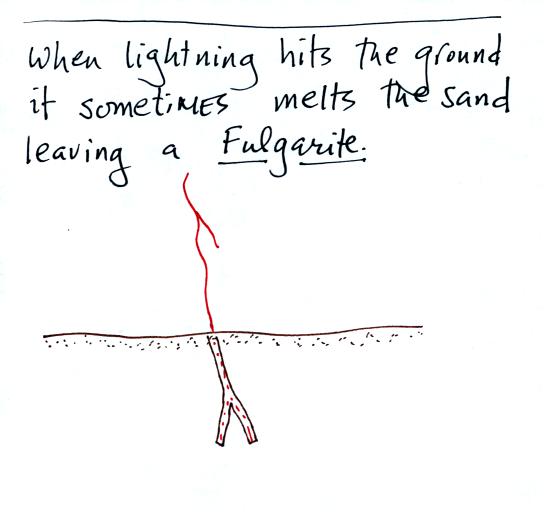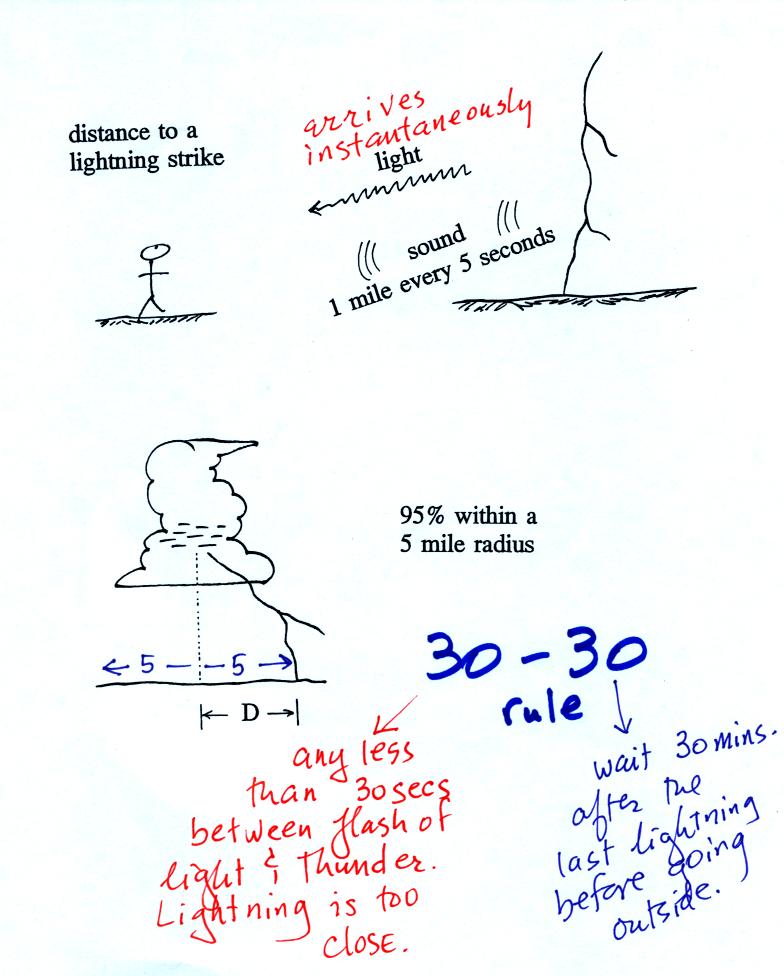Friday Dec. 5, 2008
Sorry about the long delay in getting Friday's notes online. I
was busy most of the weekend grading papers and printing out the grade
summaries. The fact that the notes are now available means the
grade summaries are done and ready to be handed out in class on Monday.
Today's music was Festival by Sigur
Ros. I am finding that I like that particular song more and
more. And it really sounds great on the sound system in ILC 140
where the T Th class meets.
The Final Exam Study Outline is now
available online. Students in the MWF section of the class can
take the final with the T Th section if they wish. You should let
me know if that is the case so that I can put your name on a list and
can be sure to bring enough copies of the exam.
A short
video was shown at the beginning of class. The video showed some
rocket triggered lightning from an installation run by the University
of Florida.
When lightning strikes the ground it will often melt the soil
(especially sandy soil) and leave behind a rootlike structure called a
fulgurite (the spelling in the figure below is incorrect). A
fulgurite is just a narrow (1/2 to 1 inch across) segment of melted
sand (glass). The video showed archaeology students excavating
around the lightning triggering site after the summer's
experiments. They were able to uncover and reveal a very long
(perhaps world record length) fulgurite.
The video showed archaeology students excavating around
the
lightning triggering site after the summer's experiments. They
were
able to uncover and reveal a very long (perhaps world record length)
fulgurite.
Lightning is a serious weather hazard and kills just under 100
people every year in the United States. We discussed some
lightning safety rules that you should keep in mind during
thundery weather.
Stay away from
tall isolated objects
during
a lightning
storm.
You can be hurt or killed just by being close to a lightning strike
even if you're
not struck directly.
An automobile with a metal roof and body provides good
protection from
lightning. The lightning current will travel through the metal
and around the passengers inside. The rubber tires really don't
play any role at all. The people in Florida that were
triggering lightning were inside a metal trailer and were perfectly
safe. All of the connections made to equipment outside the
trailer was done using fiber optics, there were no metal wires entering
or leaving the trailer.
You shouldn't use a corded phone and electrical
appliances
during a lightning storm because lightning currents can follow wires
into your home. Cordless phones and cell phones are safe.
It is also a good idea to stay away from plumbing as much as possible
(don't take a shower during a lightning storm, for example). Vent
pipes that are connected to the plumbing go up to the roof of the
house, an ideal location to be struck.
To
estimate the distance to a lightning strike
count the
number of
seconds between the flash of light and when you first hear the
thunder. Divide this by 5 to get the distance in miles.
The latest lightning safety recommendation is the 30/30 Rule.
The 30/30 rule
 People should seek shelter if the delay in seconds between
a lightning flash and its
thunder is 30 seconds or less.
People should seek shelter if the delay in seconds between
a lightning flash and its
thunder is 30 seconds or less.
People should remain under cover until
30 minutes after the final clap of thunder.
The last 15-20 minutes of class were spent on the NATS 101 Finale. It is a
compilation of 14 people that have made important contributions to
weather, climate, and atmospheric science. After a vote, students
decided that 7 questions on this semester's final exam should come from
the 14 questions on the NATS 101 Finale handout.





 People should seek shelter if the delay in seconds between
a lightning flash and its
thunder is 30 seconds or less.
People should seek shelter if the delay in seconds between
a lightning flash and its
thunder is 30 seconds or less.